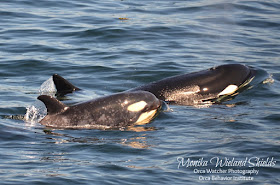On the afternoon of August 25th we heard about killer whales near Waldron Island, so I headed out to Reuben Tarte on the northeast side of San Juan Island to take a look. When I first got there, there were 2 groups, both pretty far away: one near Flattop and one near Jones. Suddenly the group from Jones, which had been aiming south down San Juan Channel, porpoised over to Spieden Channel, and it looked like both groups would go west and out of sight. Something made me pause for a couple minutes before leaving, however, and am I ever glad I did! Suddenly the two groups merged and on their next surfacing where aiming right for the rocks where I was standing! It was the T34s, T36As, T37, and T37Bs - 11 whales.
The above two photos look so much like a group of resident killer whales approaching shore at Lime Kiln. It's still amazing to me that we are having these sorts of encounters here so regularly now with transients!
It looked like they were going down on a longer dive right as they were reaching us, so I was afraid they would bypass us on shore entirely. Then I looked down and saw the unmistakable form of a killer whale underwater right off the rocks!
This was T34A, who was perhaps sent out on seal patrol, as she went up and back along the rocks, not surfacing until her return trip.
 |
| T34A |
That one close pass would have been enough to make the encounter a special one, but the rest of the whales weren't far behind. Here is a bit of an odd combination in, from top to bottom, T36A1, T37, and new calf of this year T34B.
 |
| An odd combo from top to bottom: T36A1, T37, and calf T34B |
I had seen T34B a couple times this year, but not until I saw it in this lighting did I realize how pale and mottled he or she is! Really bizarre coloration.
 |
| Odd coloring and pigmentation visible on T34B, who was traveling here with T37 |
The three T37Bs also came in fairly close and all surfaced together:
 |
| From left to right: T37B, T37B2, and T37B1 |
The whales spent some time milling near O'Neal island before getting too far away to see very well, giving me about 45 minutes of observation time from shore - quite a lot for Ts who often pass quickly right on by! This group continued south down San Juan Channel and passed Friday Harbor, but then I heard from a friend that they flipped and were coming back north. The late afternoon timing was perfect for us to jump on the boat and meet up with them again in nearly the same spot I saw them earlier, but now going north. It looked like they might take Spieden Channel, but for the second time that afternoon they doubled back and on this occasion ended up going on the north side of Spieden Island west through New Channel. Talk about a spectacular setting for an evening encounter!
There's just something about backlit blows, something made even more perfect with a black backdrop.
For the whole time I observed them on this day they kept splitting into two groups, nearly coming together and merging into one group, then splitting again, with members of the T36As and T37 regularly switching groups. It made it hard to keep track of who was where, but interesting to speculate on what they might be doing and why.
After giving us those awesome backlit blows, they switched to the other side of the channel where the lighting was equally amazing but totally different.
Yet again after no more than a minute or two they split into 2 groups, and at first we followed one as they made their way west into Haro Strait. The other one was way inshore towards Johns Pass and Stuart Island, so before we left we went over there to see what they were up to. It was a group of 5 of them and they seemingly were on the hunt, perhaps pinning a seal to the bottom as they kept taking turns diving and were circling in the same spot for more than 20 minutes.
 |
| T36A1 |
If I had to guess, I would say their hunt was successful; we started seeing some surface activity, but never anything definitive like birds coming in for meat scraps.




















































